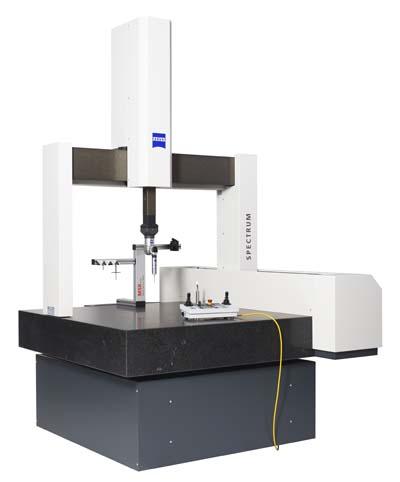
Carl Zeiss introduced the new SPECTRUM coordinate measuring machine. This bridge-type CMM reportedly meets the market's demand for an economical, entry-level CMM with Carl Zeiss machine, sensor and software technology.
Designed for general measurement, the SPECTRUM can be configured to meet your specific needs. With the Carl Zeiss RDS-C5 articulating probe holder and our XDT multi-point sensor or Renishaw TP20 touch-trigger, this CMM can measure angled features in difficult to reach locations. The articulating probe holder offers +/- 180 degrees of bi-directional rotation and permits indexing steps of 5 degrees reaching 5,184 angular positions for either sensor. SPECTRUM can also be configured with the XDT directly for general prismatic applications.
SPECTRUM models offer x, y, z measuring ranges from 700 x 700 x 600mm to 700 x 1000 x 600mm. Hard-coat aluminum guideway elements offer a variety of benefits including corrosion resistance, hardness and wear resistance, electrical resistance, temperature resistance and a low friction coefficient. The machine's accuracy of up to MPEe 2.1 + L/250 is guaranteed over a temperature range from 18 to 22 degrees C (64-71°F).
This system is equipped with a C99L Controller reducing the need for additional floor space. It provides smooth, accurate, high-speed 3-axis CNC movement for all measuring tasks and the dual-joystick panel makes motorized control easy. The ZEISS wrap-around air bearings in all guideways provide rigidity and stability at maximum speeds and accelerations.
SPECTRUM is available with user-friendly CALYPSO metrology software. CALYPSO is a revolutionary CAD-based software with Visual Metrology. There is no time-consuming, structural programming or difficult code and text editing.
Contact Details
Related Glossary Terms
- computer numerical control ( CNC)
computer numerical control ( CNC)
Microprocessor-based controller dedicated to a machine tool that permits the creation or modification of parts. Programmed numerical control activates the machine’s servos and spindle drives and controls the various machining operations. See DNC, direct numerical control; NC, numerical control.
- corrosion resistance
corrosion resistance
Ability of an alloy or material to withstand rust and corrosion. These are properties fostered by nickel and chromium in alloys such as stainless steel.
- hardness
hardness
Hardness is a measure of the resistance of a material to surface indentation or abrasion. There is no absolute scale for hardness. In order to express hardness quantitatively, each type of test has its own scale, which defines hardness. Indentation hardness obtained through static methods is measured by Brinell, Rockwell, Vickers and Knoop tests. Hardness without indentation is measured by a dynamic method, known as the Scleroscope test.
- metrology
metrology
Science of measurement; the principles on which precision machining, quality control and inspection are based. See precision machining, measurement.
- wear resistance
wear resistance
Ability of the tool to withstand stresses that cause it to wear during cutting; an attribute linked to alloy composition, base material, thermal conditions, type of tooling and operation and other variables.

